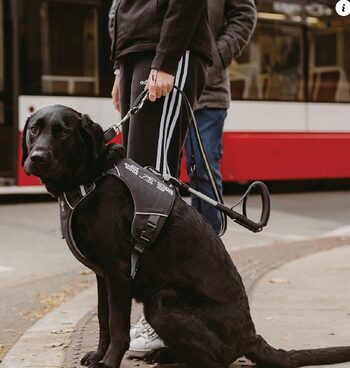 Guide dogs and service animals are more readily acknowledged today and are often seen with their handlers in every setting around town or in daily life activities.
Guide dogs and service animals are more readily acknowledged today and are often seen with their handlers in every setting around town or in daily life activities.
These highly trained animals are essential to their owner’s quality of life, safety, and ability to live independently. They have undergone specialty training and certification in assisting their human. It is important that we know how to interact with them and their owners in a way that is respectful of the important job that they have. The preferred way to do that is to completely ignore the service dog and allow it to do its job without the distraction of another person wanting to pet it.
To help you navigate your encounters with guide dogs and service animals, I’ve put together a short list:
1. Do not judge anyone you see with a service animal. They may have a non-apparent disability - that is, a disability that is not obvious to you, or they may have an apparent disability.
2. Always approach the handler, never the guide dog or service animal.
3. Never touch a guide dog or service animal. It is best if you just do not acknowledge them at all. This means no eye contact, no talking to, no making noises to try to get the dogs attention. Just no interaction at all, please. If you are that person who just cannot resist because you love dogs, you must have the handler’s permission first before touching, and accept a “no” answer if given. The handler isn’t trying to be rude to you, they are trying to ensure that their service dog is focused on their job.)
4. Never offer food or treats to a guide dog or other service animal. Service dogs can be on specific diets and eating schedules.
5. Always give service animals the right of way. Guide dogs have been trained to go around you, though it is nice if you move out of the way.
6. Keep your animals and children away from guide dogs or service animals, so as not to distract them from their job.
7. As you approach, please advise the handler of a guide dog that you have a dog with you. We cannot always see that you have a dog with you. Please leash your dog in these situations and do not allow it to interact with the working service dog.
8. Do not assume that a guide dog or service animal that appears to be sleeping or resting is off duty. They are still on the job.
9. You can tell a guide dog by the rigid harness their person holds onto. This harness allows the handler to feel their dogs movement.
10. Support dogs are not service dogs. Here in Canada Guide dogs and service animals come with certification, which means they have been trained and are legally allowed in all public spaces. Please note all countries have different rules or guidelines. Support dogs or animals – while amazing and tremendously helpful to their owners - are not certified and therefore do not have the legal protections of certified service dogs or animals.
Guide and service dogs play a vital role in the health and well-being of a person with a disability. When they are on the job, it’s essential that aren’t interrupted or distracted – the handler’s safety and life depend on the service dog doing the job that it has been trained to do! It may be trained to alert its owner to an impending seizure, panic attack, low blood sugar, or heart irregularity. Or perhaps it’s been trained to safely guide its owner who is blind. These responsibilities require the dog to be focused solely on its owner, not on getting belly rubs, head pats, or treats from strangers.
A unattended or barking service animal or guide dog could be a sign that it’s owner needs help.
